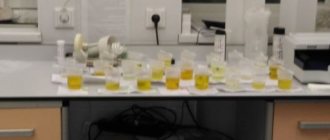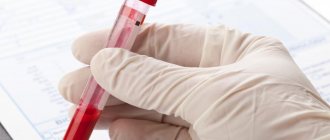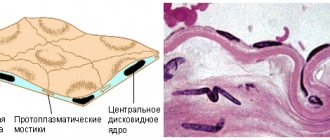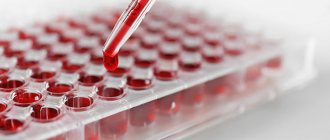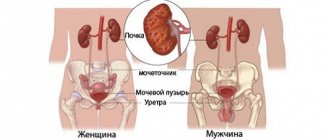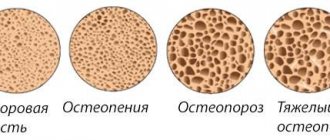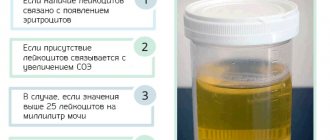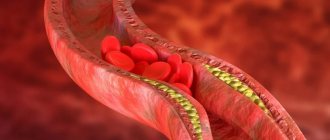White blood cells are inflammatory cells and are part of the immune system.
Therefore, their detection in increased quantities in any biological fluid indicates existing inflammation.
If a man's urine white blood cells are elevated, he requires further examination to determine the cause of this laboratory symptom.
How is leukocytosis determined?
Leukocytosis is initially determined in a general urine test.
It is carried out in three stages, during which the following are determined:
- physical characteristics (density, color, transparency)
- chemical composition (protein, glucose, hemoglobin)
- cells and substrates in urine sediment
Leukocytes are determined in the sediment using a microscopic method.
If there are more than normal, this most likely indicates an inflammatory process.
However, the method is not accurate and sometimes gives false results.
A general urine test is an indicative study.
If leukocytes are detected, additional tests are required to:
- verify the presence of leukocytosis
- determine the topic of inflammation (which organs are inflamed)
- find out its etiology (what led to inflammation)
If leukocytes in the urine are elevated, the causes of this phenomenon are most often infectious.
These can be genital infections, or nonspecific inflammation of the urethra, prostate, kidneys and other structures of the urinary system.
Leukocytes in a woman’s urine can also have gynecological causes.
Because sometimes when collecting biomaterial, discharge from the genital tract gets into it.
To prevent this from happening, you should use a tampon during the test.
Renal pathologies
Back pain
- Pyelonephritis. An ascending infection from the bladder affects the renal pelvis, causing inflammation. The leukocyte numbers in the urine jump sharply - up to 20 and above! The occurrence of pyelonephritis is facilitated by frequent colds and a generally weakened immune system.
- Kidney tuberculosis. Due to the large number of cells, the urine acquires increased turbidity and even sediment in the form of pus. Leukocyturia is reflected in the indicators and can reach huge numbers - over 40.
- Glomerulonephritis or glomerular nephritis is an infectious or allergic inflammation. There are several types of this disease - nephrotic, hypertensive, hematuric, mixed. The level of white blood cells increases in all varieties and can reach high levels, but a characteristic feature is an increased level of red blood cells and protein.
Kidney stones greatly increase the level of leukocytes in the urine, in addition to this, both blood and protein are observed
- Amyloidosis. This disorder affects men on kidney dialysis. It provokes both tumors and diabetes. An increase in white blood cells occurs when the disease progresses to the second phase.
- Cystitis. When the mucous membrane of the bladder is inflamed, the number of leukocytes in urine increases, and the disease is also accompanied by frequent urination and characteristic pain that does not go away after it.
White blood cells in the urine are increased, the reasons for this in men also lie in such diseases as:
- Diabetes. Due to the high sugar content, capillaries may become clogged, causing irritation. This is enough for leukocytes to respond to a mild inflammatory process.
- Worms. Parasites living in the intestines disrupt the integrity of the walls of the rectum. As a result, leukocytes, designed to fight the source of inflammation, enter the urine.
- STI. Syphilis, candidiasis, trichomoniasis, chlamydia, that is, diseases caused by sexually transmitted infections, gradually cause inflammation, destroying mucous membranes and organ tissue. This is how leukocytes appear in the urine - leukocyturia. If the infection is not treated, it progresses to pyuria (pus in the urine).
- Stones in the gall bladder and urinary tract. Just like kidney stones, as they progress, they provoke inflammation, to which urine analysis immediately responds.
Long-term patience and conscious refusal to urinate can also increase the level of white blood cells. Inflammation will occur due to stagnation of urine.
Another reason for changes in tests may be congenital defects of the genitourinary system: narrowed ureters, incorrect location of an organ or its size in the pelvis.
What white blood cell count is considered elevated?
Normally, no more than 5 leukocytes per field of view should be detected in the sediment.
If there are more than 8 cells, but less than 40, this is weak leukocyturia.
Moderate is diagnosed when the number of cells is up to 100 pieces per cell.
If there are so many leukocytes that they cannot even be counted, this is severe leukocyturia or pyuria (discharge of pus in the urine).
Additional methods (Kakovsky-Addis, Nechiporenko, Amburge) make it possible not only to confirm the presence of this syndrome, but also to find out which cells are secreted.
There are many types of leukocytes.
Their different types appear in various diseases:
- neutrophils – for tuberculosis, pyelonephritis
- mononuclear cells – against the background of glomerulonephritis or interstitial nephritis
- lymphocytes – for autoimmune diseases (lupus erythematosus, rheumatoid arthritis)
- eosinophils – for allergic inflammation
Normal levels of leukocyte cells in urine in men
The unit of measurement of colorless blood cells in the general analysis of urine is a digital indicator (the number of elements in the field of view - n/z). For an adult man (of fertile age), the standard leukocyte count in a general urine test is considered to be ≤ 3 in the urine (for women – ≤ 6).
Reference values for boys under 6 years of age are from 0 to 2 in p/z. In male infants (up to one year of age), the content of colorless blood cells in the urine up to 7 p/w is not abnormal. This is due to the insufficiently developed ability of children's leukocytes to protect the body (more of them are required).
In men 60+, it is allowed to exceed the normal limit by 1.5 times, which is associated with age-related changes in sexual functionality and the functioning of the renal apparatus. The norm of leukocyte cells in urine samples according to Nechiporenko and Amburge for men is ⩽2000 per 1 ml of sediment (for women – ⩽4000).
Why are women's urinary white blood cell counts twice as high as men's? This is explained by the anatomical differences of the genital organs. Penetration of bacteria from the outside into the male body is difficult due to the size of the urethra (long and narrow), in contrast to the wide and short female urethra, where germs from the vagina easily enter.
Analysis of urine sample according to Nechiporenko for leukocytosis
Urinalysis according to Nechiporenko is prescribed in case of pathological abnormalities in the general analysis.
It is often done if there is an increased content of leukocytes in the urine of men.
Before collecting biomaterial, hygiene procedures should be carried out.
The morning portion is collected in a sterile container.
It is important to collect only a medium portion.
The patient urinates into the toilet, continues to urinate into the vessel, and then releases the remainder into the toilet again.
The cap is screwed all the way down and then delivered to the clinic or laboratory.
Material for analysis is not taken:
- within 1 week after cystoscopy
- during menstruation
- while taking medications (except those prescribed by or agreed upon by a doctor)
The norm is the presence of red blood cells up to 1000 cells per 1 ml of urine, and leukocytes - up to 4 thousand cells.
Everything above indicates an inflammatory process of the kidneys.
Urinalysis according to Nechiporenko is more accurate than microscopy of sediment when performing clinical analysis.
It helps to detect hidden pyelonephritis.
Norms and deviations
Before discussing diseases that affect the organs of the urinary system, accompanied by a high content of leukocytes in the excreted fluid or leukocytosis, the features of the reference values should be studied in detail.
Firstly, normal indicators differ among people depending on gender and, secondly, among different age categories. In addition, there are several conditions in which the level of these cells may also increase. The following values are considered to be signs of health in adults: for men, 1-3 cells in the field of view of the microscope and for women – 5-7.
Ideally, no white blood cells should be detected in the sample at all. In newborns and pregnant women, normal levels are 8-10 units, which is due to minor deviations in the activity of their urinary system. And this is not regarded as a pathology.
Higher values already indicate varying degrees of infectious or inflammatory process, and the greater the deviation from the norm, the more serious and dangerous it is for the patient. So, for example, indicators of 20-25 U indicate minor inflammation, most often characteristic of infection of the lower urinary tract - urethritis (inflammation of the urethra) or cystitis (inflammation of the bladder).
When receiving microscopy results with leukocytes of 75-100 units, we can safely say that the infection has spread through the upper urinary tract. Diseases that can increase the content of white cells for such indicators are nephritis (inflammation of the kidney), pyelonephritis (inflammation of the renal pelvis) and glomerulonephritis (inflammation of the glomeruli of the kidney).
In the case where the analysis of the biomaterial showed that there are a lot of leukocytes in the smear and are described in the form with the word “entirely”, this means that it is not possible to count their number.
As a rule, their number exceeds 250-500 units in the field of view, which clearly indicates generalized inflammation of the urinary system. Often, such high rates are observed with kidney tuberculosis involving other organs of the urinary tract.
Two- and three-glass urine sample for leukocytosis
The study helps to understand why leukocytes are elevated in the urine of men.
A routine clinical urine test does not provide such information.
If signs of inflammation are found in it, then it is unknown where exactly it occurs.
Inflammatory cells can enter the urine from different parts of the urogenital tract, for example:
- urethra
- prostate
- Bladder
- kidney
- ureters
The essence of the method is that the patient urinates in 2 or 3 containers.
Everyone is tested for high levels of white blood cells.
Based on the results, an assumption is made about where the main focus of inflammation is located.
A three-glass sample allows you to obtain more accurate results.
It is performed as follows:
- The patient refrains from urinating for 3 hours or more.
- It is washed away so that in case of inflammatory processes in the area of the external genitalia, leukocytes do not enter the urine from the surface of the head of the penis or foreskin.
- Urine is collected in 3 “glasses” in the following ratio:
- into the first container – 20% of the total volume of urine
- in the second – 60%
- in the third – 20%
It is not necessary to observe these proportions exactly.
It is only important to understand that the first and last portions should be small.
The main volume of urination occurs in the middle portion.
Some doctors recommend stopping urination at the end.
After this, the prostate is massaged through the rectum, and then the remaining urine is released into the third container.
This modification of the laboratory test is used most often in patients with clinical signs of prostatitis.
Interpretation of results:
- An increase in the level of leukocytes only in the first portion usually indicates an inflammatory process in the urethra.
- A high level of leukocytes in only the 3rd sample indicates prostatitis.
- An increased level of leukocytes in the urine of men in all three “glasses” indicates the localization of inflammation in the organs of the urinary system (kidneys, ureters, bladder).
- If the first and third portions show leukocytosis, while there are no pathological changes in the second (middle) portion, this indicates simultaneous inflammation of the urethra and prostate.
Most likely, we are talking about a primary lesion of the urethra with the subsequent development of an ascending infection.
Thus, a three-glass or two-glass test makes it possible to determine the causes of increased leukocytes in the urine in men by determining the topic of damage to the genitourinary tract.
Diagnostics
Isolated leukocyturia is not an indication for diagnosis. Additional examinations of urine, blood and internal organs are mandatory.
Methodology
The easiest and cheapest way to confirm the presence of inflammation in the genitourinary system is to perform a general urine test. In this case, the main biochemical indicators (protein, glucose, ketone bodies, pigments, nitrogen metabolism substances), relative density, color and transparency are assessed. The laboratory assistant also conducts microscopy of the sediment, where cells, bacteria and cylinders are found.
A general clinical examination of urine reflects only the fact of the presence of inflammation. More accurate data on the number of shaped elements requires the use of the following methods:
- According to Kakovsky-Addis. Cell counts (including red blood cells and casts) are performed in urine collected per day.
- According to Nechiporenko - the level of leukocytes in 1 ml of urine.
- Two- and three-glass samples. Consistently collected material is examined with a certain time interval in a medical institution. The presence of the largest number of bacteria or leukocytes in the 1st portion indicates inflammation of the outlet section, in the 2nd - the bladder and kidneys, in the 3rd - severe damage to the pyelocaliceal system or prostatitis.
These tests are also used for dynamic monitoring of the course of the disease and control of treatment, especially if it is latent or sluggish.
Preparation
To avoid false results, you must adhere to the following rules:
- For 2-3 days, avoid the consumption of alcoholic beverages, intense physical activity and, if possible (as determined by the doctor), medications.
- For general analysis, an average portion of morning urine is collected after toileting the external genitalia. You should not smoke the day before.
- Use a disposable container (sold in any pharmacy, the price is minimal) or a clean, dry glass jar with a tight-fitting lid.
- The first few milliliters are flushed down the toilet. Next, without stopping urination, place the container. Having collected 100-150 ml, the last portion is also lowered.
It is important to know! The material must be transported to the laboratory within 1-1.5 hours, avoiding strong shaking or overheating of the container.
Is additional research needed?
To make a correct diagnosis in order to select the most appropriate treatment, the following measures may be required:
- General and biochemical blood test.
- Bacteriological examination of urine (culture on nutrient media to determine the sensitivity of the isolated strain to antibiotics) after prostate massage.
- Assessment of the functional state of the kidneys: Zimnitsky, Rehberg, Volgard tests.
- Ultrasound of the kidneys, pelvic organs and prostate (transrectal).
- Microscopy of prostate secretion.
- Examination of smears from the urethra if a specific nature of the disease is suspected (most often sexually transmitted infections - syphilis, gonorrhea, chlamydia).
- Spermocytogram.
- Digital rectal examination.
- According to indications - puncture of the kidneys, prostate, bladder, followed by morphological examination (the gold standard for diagnosing oncological pathology).
Advice! To exclude other causes, consultation with related specialists may be required. As a result, the doctor evaluates the results obtained in combination with medical history, complaints and existing symptoms.
Urine PCR for infections with leukocytosis
The previous analysis we discussed helps to understand where inflammation occurs.
However, the etiological factor remains unclear.
There are many bacteria and other microorganisms that can be responsible for the inflammatory process.
Sometimes it is E. coli or other opportunistic flora.
However, with inflammation of the urethra or prostate, we often have to talk about genital infections.
They are caused by various pathogens.
These can be not only bacteria (gonococcus, chlamydia), but also protozoa (Trichomonas) or fungi (Candida).
Sometimes, against the background of viral sexually transmitted infections (herpes, HPV), secondary bacterial flora is added.
In this case, the level of leukocytes also increases.
If you suspect an STD, it is important to understand what type of microorganism caused the inflammation.
Because different infections are treated with different drugs.
For etiological diagnosis, PCR is used.
This is a molecular biological method that allows you to identify a specific DNA fragment of a pathogen.
Using this code, which is compared with the sample, one can judge the presence of a pathogen in the urogenital tract.
If necessary, the DNA concentration can be determined.
A urine test can be used to identify the cellular forms of STD pathogens.
But if a viral infection is suspected, it is better to examine a scraping of the urethral epithelium, since in this case the diagnosis will be more accurate.
Urine culture for elevated leukocytes
Culture is another method of etiological diagnosis.
Usually sowing is done for:
- identifying excessive growth of opportunistic flora (bacteria that normally live in the genitourinary system, but as a result of intensive reproduction can initiate inflammation)
- assessing the level of sensitivity of isolated bacteria to antibiotics
The study is quantitative.
The unit of measurement is colony forming units.
When a microorganism is detected in a concentration of 10 to 4 CFU or higher, it is concluded that this particular bacterium is the cause of increased leukocytes in the urine of a man.
There may be several such pathogens at once.
If bacteria grow in concentrations below the threshold value, it is believed that this flora does not participate in the inflammatory process.
For all microorganisms that are found in quantities greater than 10 to degree 4, antibiotic sensitivity is assessed.
This helps the doctor immediately prescribe treatment that is likely to be effective.
Because the drug to which the isolated pathogens have the highest susceptibility is selected for therapy.
How to diagnose a deviation from the norm?
The determination of leukocytes is carried out during a general urinalysis (UCA), the main method of primary laboratory diagnosis. The study is assigned:
- according to the patient’s characteristic complaints about disease symptoms;
- during a routine health check (screening of pregnant women, medical examination, admission to work or study, intravenous medical examination, etc.);
- as a control of treatment results (for diagnosed pathology).
Evaluation of the analysis results consists of comparing the obtained leukocyte indicators with the accepted reference values. In addition, the doctor compares the presence of leukocyturia with other abnormalities in the analysis, in particular, hematuria - an increased concentration of red blood cells (erythrocytes) in the urine.
If the leukocyte count is elevated, the doctor may refer the patient for additional urine tests:
- Nechiporenko test;
- Addis-Kakovsky sample;
- Amburger's sample.
Advanced diagnostics are performed to confirm leukocyturia and hematuria. Red blood cells in urine are allowed in minute quantities: no more than 1–2 cells in men, no more than 3 in women. In addition, additional samples reveal cylindruria - the presence of cylinders in urine.
Cylinders are protein formations in the renal tubules that appear in the urine during the development of pathological processes and dysfunction of the renal apparatus. In healthy urine, only a small amount of hyaline casts is allowed. Other varieties (granular casts, epithelial, erythrocyte, waxy) should be absent.
Ultrasound for increased leukocytes in urine
Using ultrasound you can examine:
- kidneys and bladder
- scrotal organs
- prostate gland
An ultrasound of the kidneys and bladder is performed with a moderately full bladder.
An ultrasound may show signs of cystitis or pyelonephritis.
The method allows you to detect stones in the structures of the urinary system.
Sometimes the appearance of leukocytes in the urine is caused by orchiepididymitis.
One of the methods for diagnosing this disease is ultrasound of the scrotum.
No preparation is required to conduct the study.
Prostate ultrasound is performed to diagnose prostatitis, benign hyperplasia or malignant prostate tumor.
The examination is carried out through the rectum.
The sensor is located in close proximity to the organ being used.
Preparation for the study does not affect the information content of ultrasound.
But given the method of conducting the study, it is highly advisable to go to the doctor after defecation and thorough toileting of the anal area.
Some clinics will ask you to do an enema before the ultrasound.
Rules for taking a urine test
Urine tests may seem like something very simple, requiring no effort on the part of the patient. This is partly true, but it is worth remembering the basic rules of preparation.
By following them, the patient will increase the reliability of the study and eliminate the negative impact of external factors on the results, which is sometimes very important.
Doctors recommend following these tips:
- abstain from sexual relations for 24-48 hours;
- try to exclude from your diet a few days before the study fast food, spicy foods, foods with a lot of spices, and too fatty foods;
- It is strictly forbidden to drink alcohol the day before; it is recommended not to smoke at least 24 hours before the test;
- it is important to properly toilet the genitals the day before, thoroughly rinsing them with running water, but refusing to use products that have an antibacterial effect or an irritating effect;
- You need to acquire dishes in advance for collecting biological material (a special sealed jar can be purchased at a pharmacy; homemade dishes are absolutely not suitable for collecting analysis!).
Following simple rules ensures that the results are reliable. This means that the patient will not have to undergo the examination again. And the doctor will get the maximum benefit from the results of the study.
Treatment for increased leukocytes in urine
Doctors do not treat tests or laboratory symptoms, but specific diseases.
Laboratory diagnostics either help to understand what a person is sick with.
The presence of a large number of leukocytes in the urine is a nonspecific syndrome.
It occurs in a large number of different diseases.
They all require a different approach to treatment.
If a person is diagnosed with genital infections, antibiotic therapy is carried out.
Different drugs are used for different STDs.
Therefore, the choice of treatment regimen is made after a thorough diagnosis.
If the pathogen is known, appropriate drugs are prescribed to destroy it.
Medicines used for various infections:
- gonorrhea - ceftriaxone
- trichomoniasis – ornidazole
- chlamydia - doxycycline
- candidiasis - fluconazole
Nonspecific urinary tract infections are common.
These can be prostatitis, cystitis, pyelonephritis.
Pathologies are most often caused by E. coli.
It has good susceptibility to fluoroquinolones.
Therefore, treatment can be carried out with levofloxacin or other drugs of this group.
But it is worth considering that although E. coli is most common, there are also cases when:
- infections are caused by other pathogens, including non-bacterial ones
- In addition to E. coli, other flora is present
Therefore, treatment can be prescribed empirically.
But it can be adjusted after receiving the results of laboratory tests.
Urolithiasis is a predisposing factor that provokes repeated inflammatory processes of the genitourinary system.
To treat it, it is necessary to remove stones using one or another method.
Which methods will be used depends on the size of the stones, their chemical composition, quantity, and location.
Dissolution of stones with drugs, their crushing (lithotripsy) or surgical removal are used.
If leukocyturia is caused by Mycobacterium tuberculosis, the patient is prescribed long-term treatment with several antibiotics.
Often it is necessary to resort to surgical methods.
Sometimes leukocytes appear as a result of autoimmune damage to the kidneys or other organs of the urinary system.
Then anti-inflammatory drugs and glucocorticoids are used for treatment.
Most of these diseases are chronic and cannot be cured.
The patient is forced to receive drug therapy constantly.
Dependence on age-related changes
When a urine test was taken to determine the level of leukocytes in a child and it turned out to be elevated, there is no need to sound the alarm. This depends, first of all, on the process of the fetus passing through the tubes during birth; patches of blood ended up on the scalp. Even during birth, infections of the newborn's urinary system occur due to the mother's unclean fluids.
When a doctor conducts a urine test, every man over the age of 30 may end up with a mild abnormality. This begins against the background of hormonal fluctuations in the body (when the greatest number of hormones are at their highest concentration).
A common reason for a high concentration of purulent contents of white cells in the urine of a man about forty years old is urethritis and stagnation of urine. These diseases will increase the anomalies of the analysis indicator by three or ten units.
In other moments the following happens:
- infections that are transmitted through the genital tract;
- presence of feces on the canal;
- inflammation of the mucous membranes of the urethra, including the ovary.
The male gender is different from the female. A man under fifty years old in a normal situation has a urine indicator as follows: leukocytes up to three units maximum, but perhaps a deviation of one or two units. The most common cause of diseases of this age is the inflammatory process in the prostate.
The question of what the norm of white bodies is is relative. The norms for the content of white cells in the urine of elderly men over 63 years of age range from zero to five units.
Sixty-year-old men often complain to doctors about kidney pathologies. Less than half of older men of this age suffer from problems with the prostate, or rather its function.


